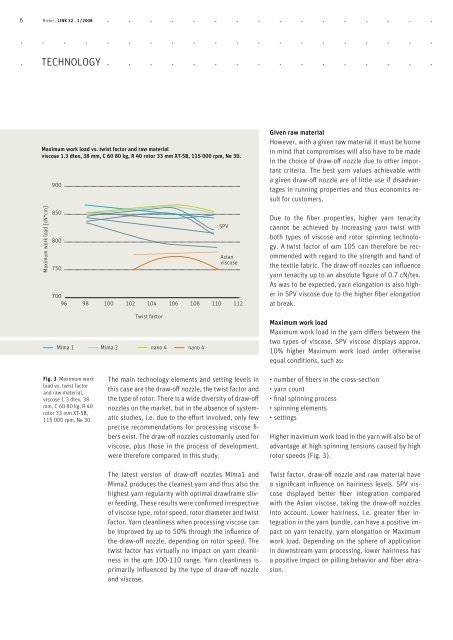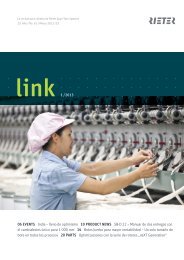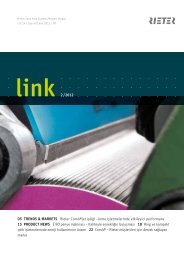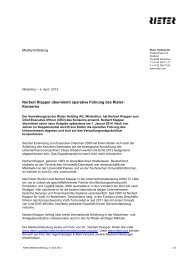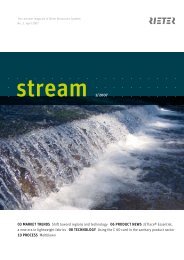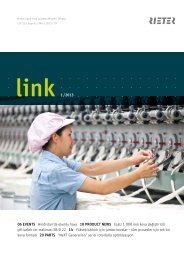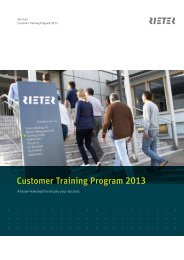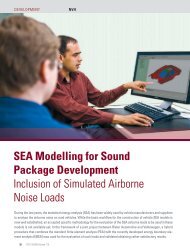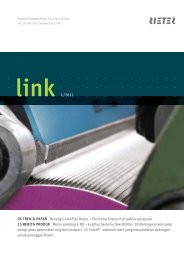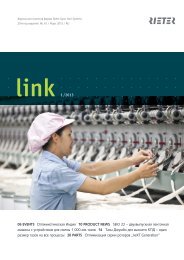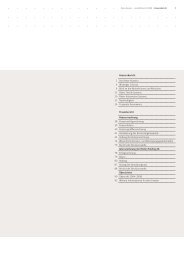Create successful ePaper yourself
Turn your PDF publications into a flip-book with our unique Google optimized e-Paper software.
6 <strong>Rieter</strong> . <strong>LINK</strong> 52 . 1 /2008<br />
TECHNOLOGY<br />
Maximum work load vs. twist factor and raw material<br />
viscose 1.3 dtex, 38 mm, C 60 80 kg, R 40 rotor 33 mm XT-5B, 115 000 rpm, Ne 30.<br />
Maximum work load [cN*cm]<br />
900<br />
850<br />
800<br />
750<br />
700<br />
96 98 100 102 104 106 108 110 112<br />
Mima 1 Mima 2 nano 4 nano 4<br />
Fig. 3 Maximum work<br />
load vs. twist factor<br />
and raw material,<br />
viscose 1.3 dtex, 38<br />
mm, C 60 80 kg, R 40<br />
rotor 33 mm XT-5B,<br />
115 000 rpm, Ne 30.<br />
Twist factor<br />
SPV<br />
Asian<br />
viscose<br />
The main technology elements and setting levels in<br />
this case are the draw-off nozzle, the twist factor and<br />
the type of rotor. There is a wide diversity of draw-off<br />
nozzles on the market, but in the absence of systematic<br />
studies, i.e. due to the effort involved, only few<br />
precise recommendations for processing viscose fibers<br />
exist. The draw-off nozzles customarily used for<br />
viscose, plus those in the process of development,<br />
were therefore compared in this study.<br />
The latest version of draw-off nozzles Mima1 and<br />
Mima2 produces the cleanest yarn and thus also the<br />
highest yarn regularity with optimal drawframe sliver<br />
feeding. These results were confirmed irrespective<br />
of viscose type, rotor speed, rotor diameter and twist<br />
factor. Yarn cleanliness when processing viscose can<br />
be improved by up to 50% through the influence of<br />
the draw-off nozzle, depending on rotor speed. The<br />
twist factor has virtually no impact on yarn cleanliness<br />
in the αm 100-110 range. Yarn cleanliness is<br />
primarily influenced by the type of draw-off nozzle<br />
and viscose.<br />
Given raw material<br />
However, with a given raw material it must be borne<br />
in mind that compromises will also have to be made<br />
in the choice of draw-off nozzle due to other important<br />
criteria. The best yarn values achievable with<br />
a given draw-off nozzle are of little use if disadvantages<br />
in running properties and thus economics result<br />
for customers.<br />
Due to the fiber properties, higher yarn tenacity<br />
cannot be achieved by increasing yarn twist with<br />
both types of viscose and rotor spinning technology.<br />
A twist factor of αm 105 can therefore be recommended<br />
with regard to the strength and hand of<br />
the textile fabric. The draw-off nozzles can influence<br />
yarn tenacity up to an absolute figure of 0.7 cN/tex.<br />
As was to be expected, yarn elongation is also higher<br />
in SPV viscose due to the higher fiber elongation<br />
at break.<br />
Maximum work load<br />
Maximum work load in the yarn differs between the<br />
two types of viscose. SPV viscose displays approx.<br />
10% higher Maximum work load under otherwise<br />
equal conditions, such as:<br />
• number of fibers in the cross-section<br />
• yarn count<br />
• final spinning process<br />
• spinning elements<br />
• settings<br />
Higher maximum work load in the yarn will also be of<br />
advantage at high spinning tensions caused by high<br />
rotor speeds (Fig. 3).<br />
Twist factor, draw-off nozzle and raw material have<br />
a significant influence on hairiness levels. SPV viscose<br />
displayed better fiber integration compared<br />
with the Asian viscose, taking the draw-off nozzles<br />
into account. Lower hairiness, i.e. greater fiber integration<br />
in the yarn bundle, can have a positive impact<br />
on yarn tenacity, yarn elongation or Maximum<br />
work load. Depending on the sphere of application<br />
in downstream yarn processing, lower hairiness has<br />
a positive impact on pilling behavior and fiber abrasion.


